

|

|
In the News
Paul Rose: Master Modeler (Part 2)
Feb 17, 2010


By Noel Widdifield |
Author
Bio
Last week we learned about Paul Rose and some of the impressive modeling he has done with his kitbashing of steam locomotives. This week we will finish up with the final steam locomotive project and hear about his work with power supplies, diesels, cabooses and other rolling stock. We will also take a look at some of the HO models he still has on display in his basement.
|
Last week we learned about Paul Rose and some of the impressive modeling he has done with his kitbashing of steam locomotives. This week we will finish up with the final steam locomotive project and hear about his work with power supplies, diesels, cabooses and other rolling stock. We will also take a look at some of the HO models he still has on display in his basement. The thing that is so impressive about what Paul does, is that there are almost no other modelers doing this in Large Scale. His models are all standard gauge and his models are of locomotives that are not found anywhere else. Because of his skill, his models are almost perfect representations of the real thing. These are extremely accurate models of prototypical locomotives. A perfect example is the next locomotive, a Baltimore & Ohio "Big 6", 2-10-2. It is also made from a Mallet. He used two Mallet drives that were cut and joined together for the 10-wheel drive. Both the original motors run to power the loco. The boiler was cut and then put back together to shorten it to the appropriate length. He removed the Mallet pilot assembly and built a correct one. He centered the smokebox door and the resulting model is a very accurate representation of the real thing. 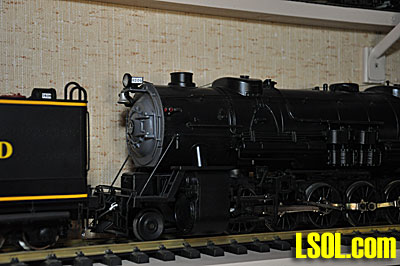
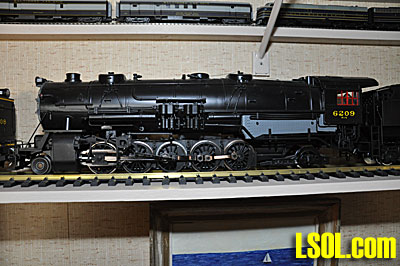
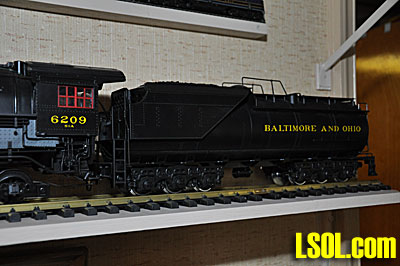
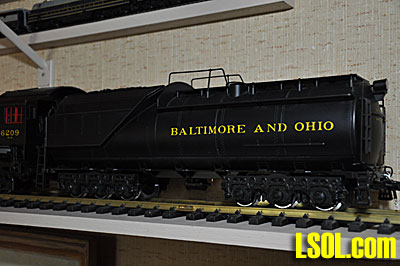
The last steam loco we looked at was the Baltimore & Ohio EL-2, 2-8-8-0 with a three-truck tender. The B&O had three of these three-truck tenders. This 2-8-8-0 is modeled with the driving wheels moved aft and the spacing closed up between them. As we discussed his modeling, Paul confessed that he couldn't always remember what he had done to the locos, because of the time passed since he built them, but each one is a truly unique model. 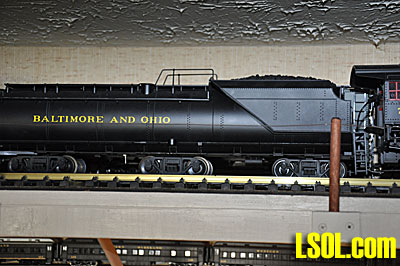
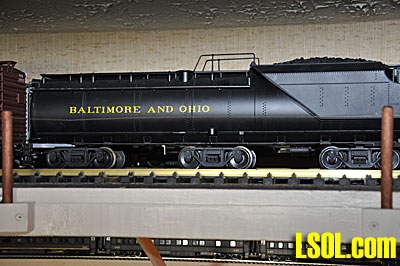
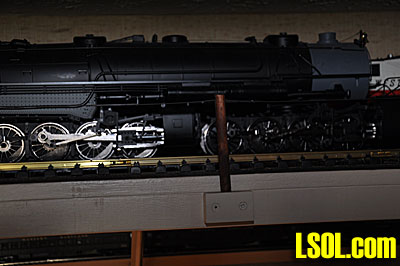
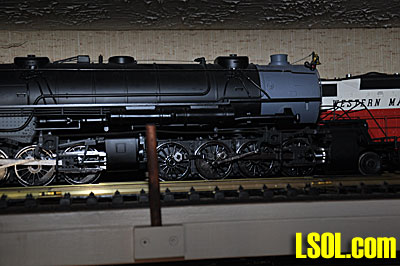
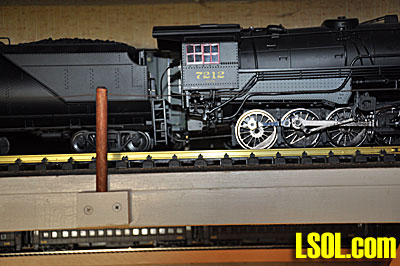
Paul has several power supplies to power his railroad. They include a Heathkit that he built over 35 years ago. It is a 25-amp supply. He has his power supplies set up on benches that were torn out of the electronic labs at the local Junior College. Everything in his power set up is metered. All of his battery chargers for his sound systems are set up in this configuration as well. He puts Phoenix sound systems in trailing cars for his diesels and in the tenders of his steam locos. Some of his early diesels do have sound systems in them. Using the trailing car allows him to have fewer sound systems, saving money, but still allowing sound in anything he is running. He mounts the speakers in the sound cars facing forward so that the sound seems to be coming from the locos. He uses 4-inch speakers mounted in an enclosure facing forward. He gave me a demonstration and I could not tell that the sounds were coming from the boxcar rather than the loco. 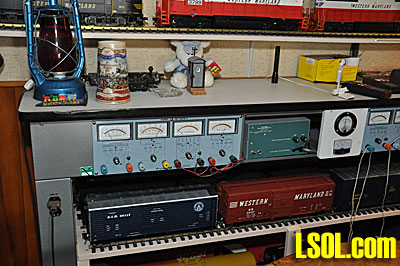
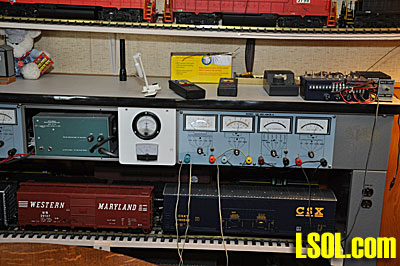
There are 3 cab diesels in this bunch, a USA F-3 painted, lettered, and detailed in the WM fireball scheme. The FAs are an early (fireball scheme) a later (speedletter scheme) by Aristo. These locos require different modification depending on when they were manufactured. The newer models are a lot more prototypical and functional than the earlier models and therefore require fewer modifications. 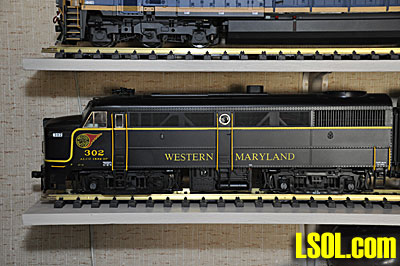
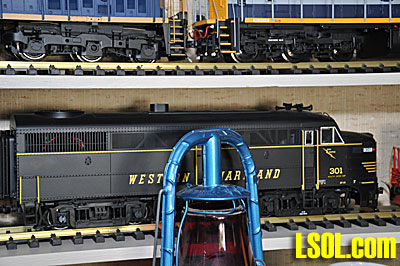
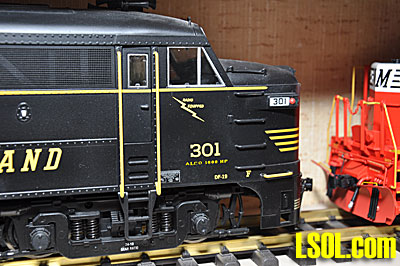
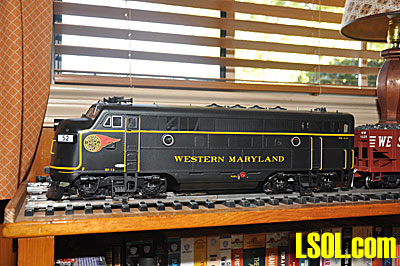 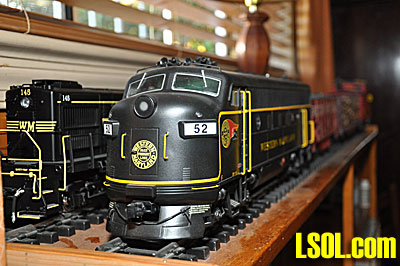

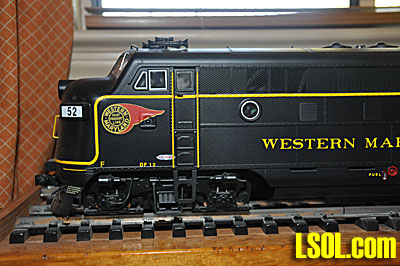
Many of his diesels have snowplows added. The plows were designed by Paul but were fabricated for him from aluminum. Paul graciously offered to give me a few and I accepted. He says he has a "lifetime supply". 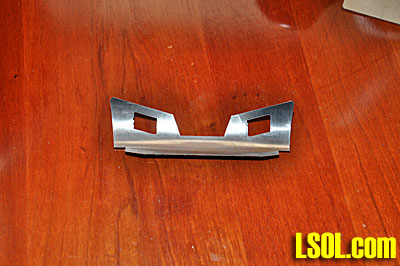
He showed me an SD-35 made from a GP 38 and a SD-40 made from a SD-40-2 by cutting a half-inch out of one porch and 3/4 inch out of the other porch and converting the HTC truck side frames back to straight heavy duty flexi-coils and putting Aristo Craft motor blocks in both the locos. 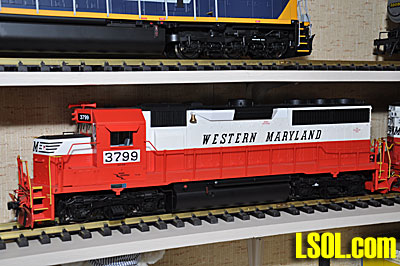
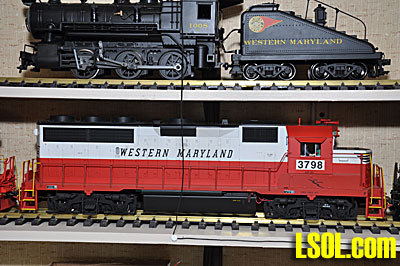
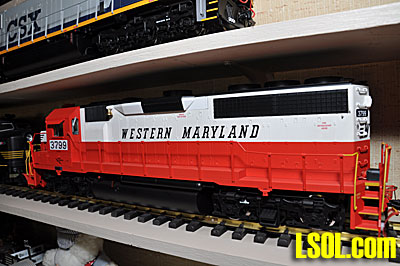
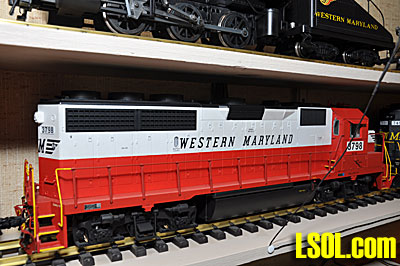
Paul has several of the modern diesels that he has kit-bashed to look like the real thing. He uses correct colors for the paint and makes them authentic for the railroad they run on. He started with a Dash 9 and turned it into an AC-44. The main difference between the two is the big inverter cabinet because it is an AC locomotive. The air conditioner box was moved from the side to the cab of the loco. And because CSX had full dynamic braking, there is a third dynamic brake setup seen in the vents on the side of the loco. Because CSX has their lights and number boards down on the front, they were moved from above on the Dash 9. The loco has also been lowered to the correct height. 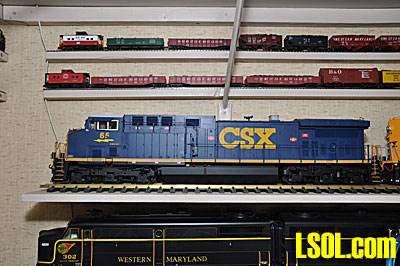
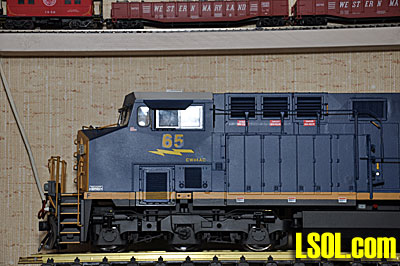
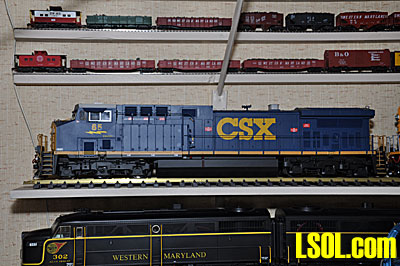
The USA Trains SD-70 is almost a stock unit except for detailing and a major drive train alteration. He put Aristo Craft motor blocks under it. 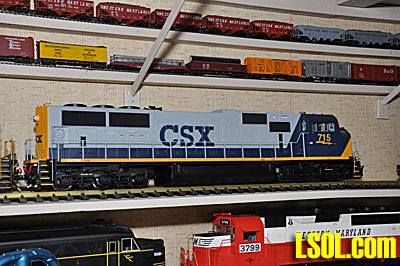
He has several other diesels that he has detailed and modified and every one is prototypical based upon the road for which it is lettered. He even has a chopped nose Western Maryland Geep in the circus scheme. He started with a USA Trains GP-7 and cut down the hood and modified it with Aristo Craft motor blocks. 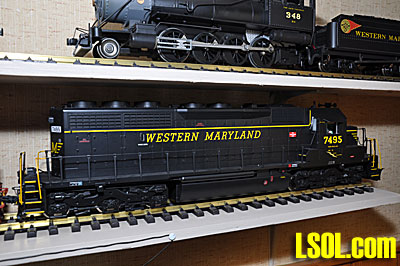
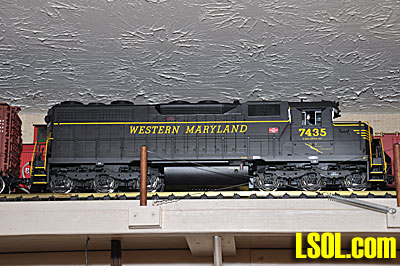
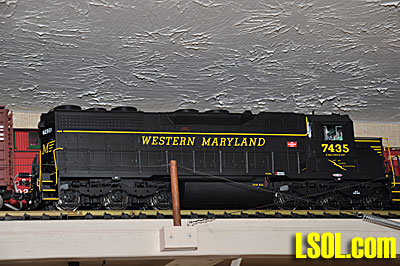
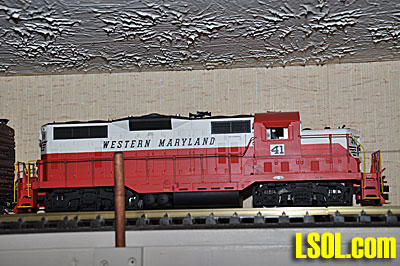
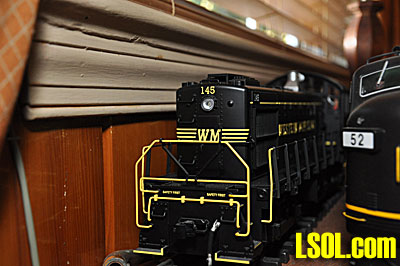
I found one of thing that was not prototypical on his railroad and asked him how he came by it. He said that it was given to him and although Western Maryland never had one, it did now. 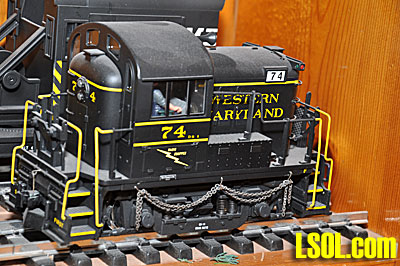
Paul is very proud of his caboose collection. He showed me a Western Maryland NE Style caboose that started as an Aristo Craft Long Caboose. He moved the copula to the center, moved the windows, rebuilding the end platforms, putting the end steps on and lengthened the wheelbase to the correct length. 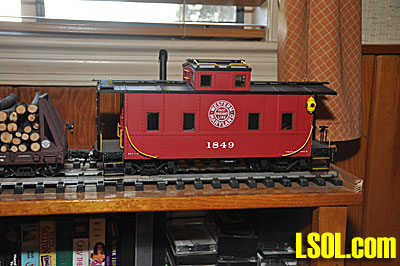
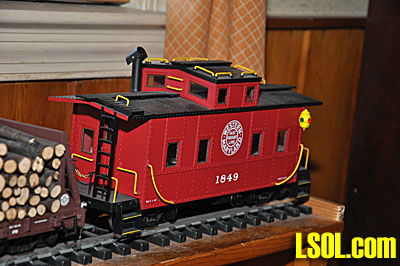
Paul explained that he takes a stock caboose and cuts the window section out of each side and then swaps them around using half of the window sections from two cabooses to achieve the correct window arrangement he is looking for. The comparison between the stock caboose and the finished caboose illustrates the result. 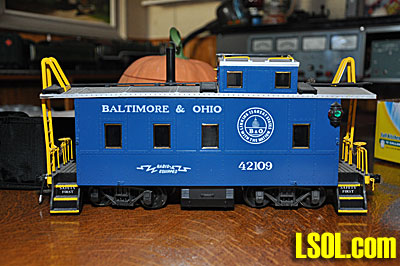
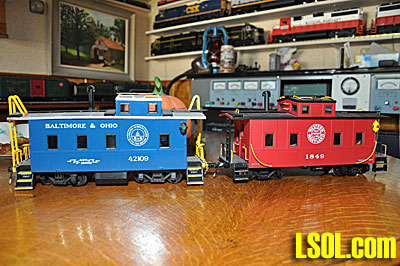
He is particularly proud of his B & O bay window caboose. It started life as a USA Trains caboose, but it was shortened to the correct length for the B & O. He cut, plugged, modified, removed windows and stretched the wheelbase so that it looks almost identical to B & O 2858 as it was in the early 1960's. He even added the vandal screening over the windows. 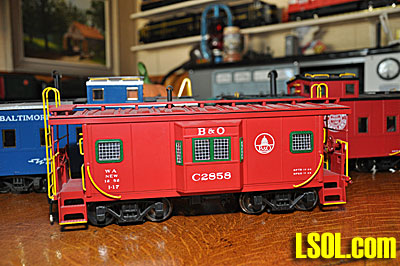
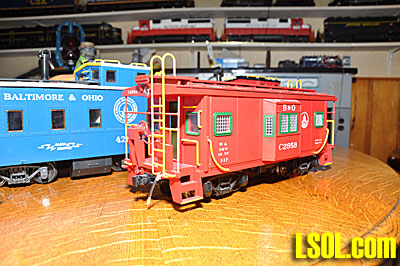
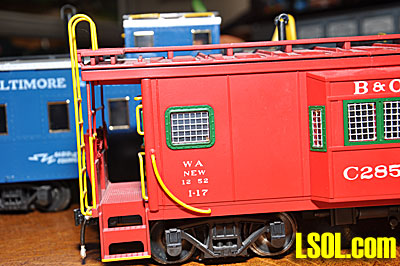
There are several boxcars that Paul uses for his sound cars and many other pieces of rolling stock that he has modified to make prototypical. These include the depressed flat car with a ship's propeller that he entered in the LSOL.com model contest at the ECLSTS and took away two major prizes. He made it from a pair of USA Trains depressed flat cars and a pair of Aristo Craft commonwealth tender trucks, and the prop came from a trailer hitch. Paul built the prop car because he had seen the B & O cars delivering things like that coming into the navel base at Bayonne, New Jersey. Much of his modeling involves just getting the paint scheme right on the rolling stock. 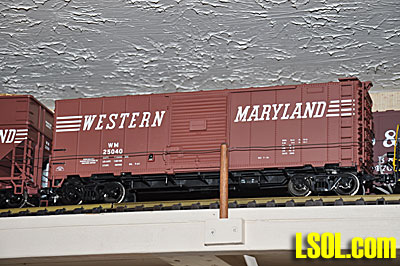
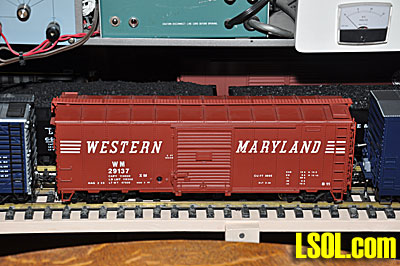
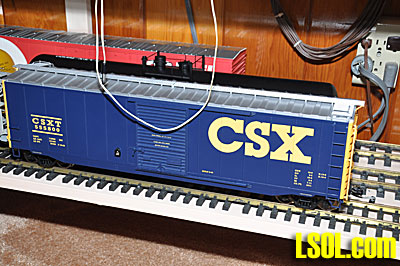
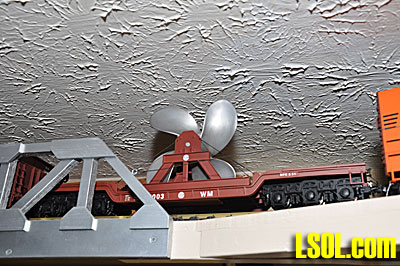
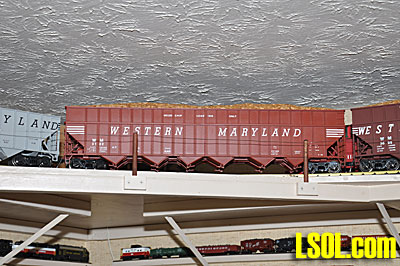
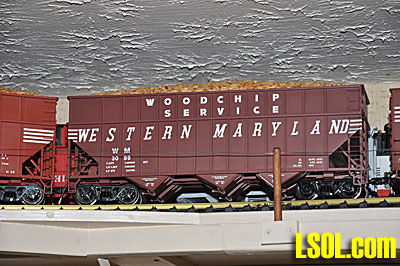 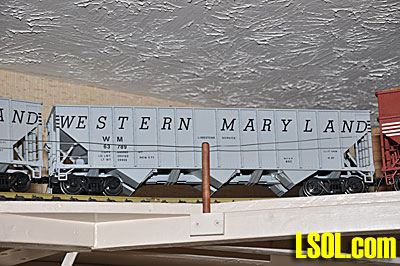
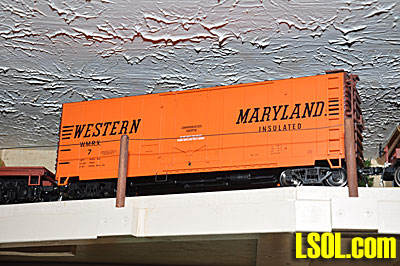
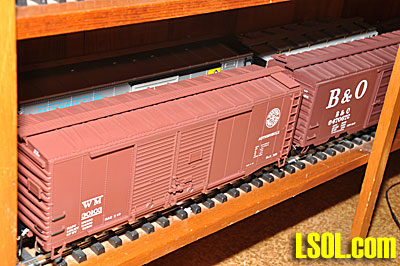
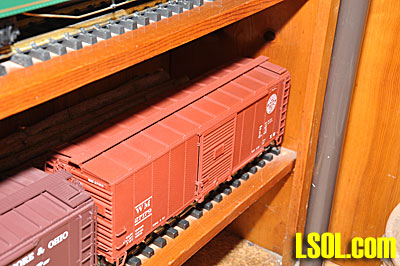
Since Paul modeled for years in HO, he still has much of his 1950's HO still in his collection. Some of it is 50 years old and none are less than 20 years old. A lot of his collection was built from kits, many of them Westerfield kits. He even has some passenger cars in his HO collection. 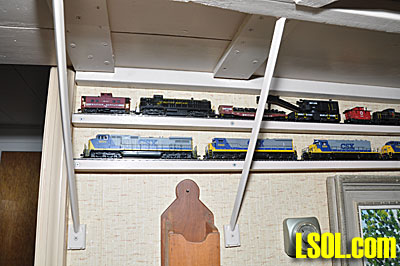
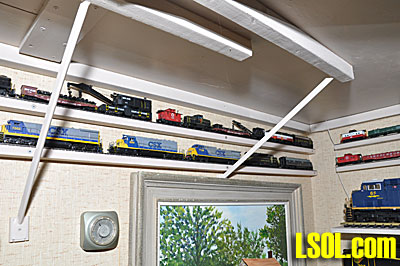
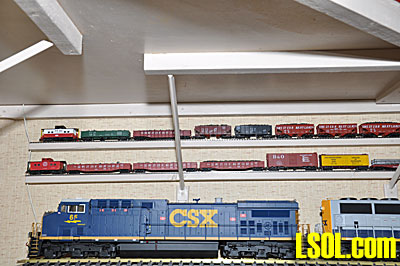
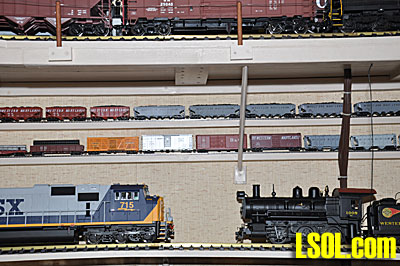
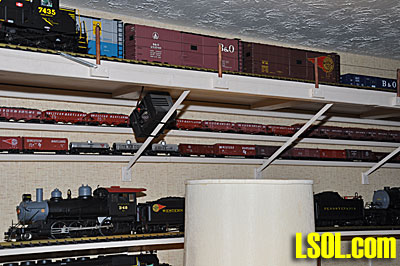 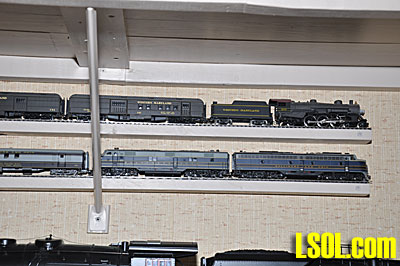
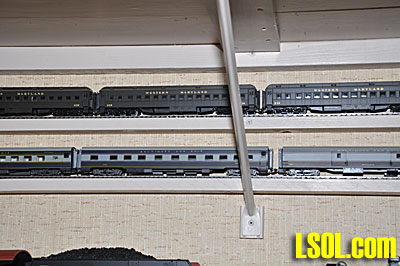
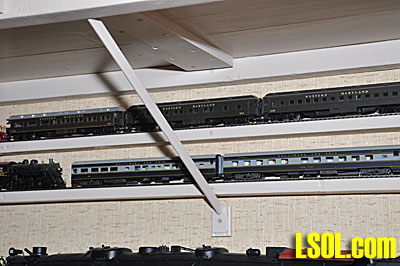
Paul allowed me to visit his "office" work area and headquarters. He does most of his work here and also does all of his inside photography in this location. 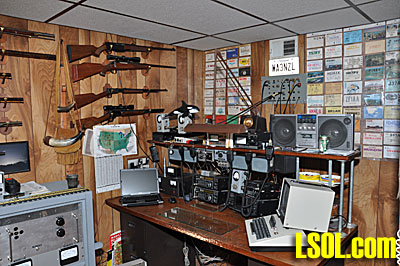
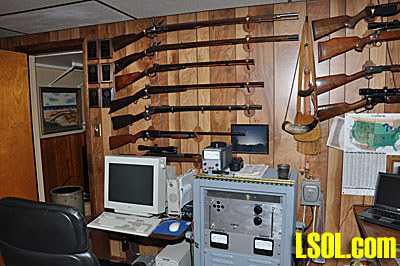

From his office we moved out to his garage to see the real workshop. He has all of the tools for the restoration of automobiles and motorcycles and they are very useful for his train hobby. He says that he has the tools to make anything he wants, including a professional lathe. He currently has the lathe set up to trim the axles to fit in the ball bearings for the wheels on his trucks. 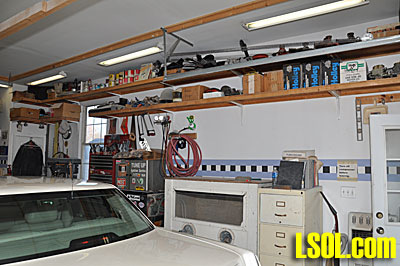
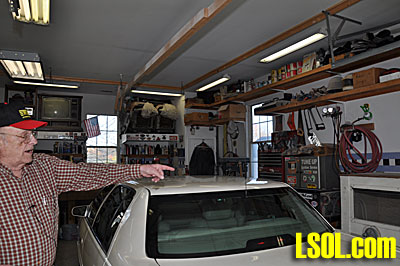
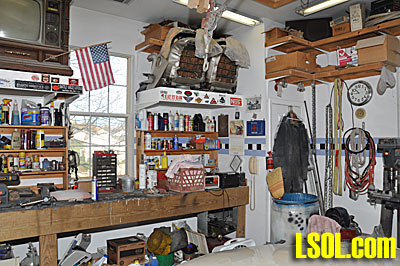
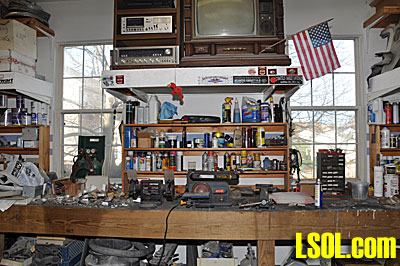
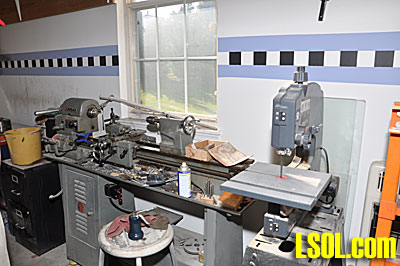
The final few minutes were spent looking through the attic over the garage that is filled with train boxes, track, parts and unused locos and rolling stock. Whenever he starts a project, this is where he comes to find the basic parts for his work. His attic looks like where most of us store all of our "stuff". It is nice to know that someone as professional as Paul has a "junk" room.I look forward to the Spring ECLSTS to see what Paul brings to the show to run on the modular railroad and to see what he enters in the LSOL.com model contest. In a hobby that generally is based upon people who buy their railroad locos and rolling stock ready to run and seem to be afraid to even think about modifying, kitbashing or stratchbuilding, Paul is almost one-of-a-kind. Paul is a true model railroader modeling in Large Scale and is an inspiration to each of us who have the urge to take out a loco or car and use a razor saw to turn it into something more prototypical. As the hobby matures, we will see more and more hobbyists' doing what Paul does with his models.
| Three truck tender |
| This is the first time I had seen the Baltimore & Ohio EL-2, 2-8-8-0 with a three-truck tender. I did manage to find a photo of the prototype. http://www.northeast.railfan.net/images/bo7212s.jpg I also found a EL-3a class 2-8-8-0 with the same 3-truck tender. http://www.northeast.railfan.net/images/bo7120s.jpg |
| Rick Henderson - 02/17/2010 - 06:45 |
| Long tradition of kitbashing locos |
| There was a long series of articles in Model Railroader back in the 1950's by Bill Schoup. Mr. Schoup used to take the available HO gauge engines and kitbash them into other locomotives. Then he would write articles detailing how he did it. It is nice to see that this kitbashing tradition is continuing. There is a lot that can be done with the Aristocraft mallet and pacific locomotives. Also, plastic can be a lot easier to work and rework than the old cast zamnak of the 1950's HO locomotives. Maybe this article will inspire others to do more than just take a loco out of the box and put it on the tracks. |
| Stephen Auslender - 02/17/2010 - 07:21 |
| Incredible modeling |
| Wow! Awesome work! I know I'll be looking for his models at the ECLSTS this year! |
| David VanBronkhorst - 02/17/2010 - 16:19 |
| Paul Rose |
| Thanks Noel for introducing us to the industrious Paul Rose. Personally I just like to run trains pretty much as they come but can certainly appreciate the efforts and quality others pursue. |
| Phill Lowe - 02/18/2010 - 10:14 |
| Aristo Craft motor blocks |
| I would like to know why swapped out the USA motor blocks for Aristo Craft motor blocks in his Diesels? |
| Raymond abbott - 02/18/2010 - 13:52 |
| Aristo Motor Blocks |
| Raymond, You should ask Paul directly, but I think he felt that at that time the Aristo motor blocks were stronger and more reliable than the USA ones. I believe that he feels that USA Trains has solved that problem a few years ago. Noel |
| Noel Widdifield - 02/19/2010 - 10:09 |
| Paul's Work |
| Both installments of Paul's work have been most interesting. Enjoyed looking at his work, it is outstanding. Appreciate his work being showcased here on LSOL. Look forward to seeing some of Paul's work at the ECLSTS. |
| JD Miller - 02/19/2010 - 10:18 |
| B&O and WM |
| Living in Baltimore county I've been to the B&O round house many times. Moving to the hills of WV just below Cumberland Md I've walked the ghost tracks and bridges of WM. The artical gave me some history on old WM engines. Good job! |
| Capper - 02/19/2010 - 11:57 |
| Dash -9 |
| Maybe Paul could share how he lowered his Dash-9 to make it more prototypical. My sons call me detail crazy. There is not a single engine that I have that has not been taken apart, researched and modified right out of the box. My Dash-9 has a great deal of detailing but looking straight at it, the space between the frame and trucks does not look real. |
| Louis K. Steffenhagen - 02/20/2010 - 03:39 |
Top of Page
|
|

|
IMPORTANT LINKS

Get Your Official Diploma

Watch New Videos


New Products Online
|
|
|

|



